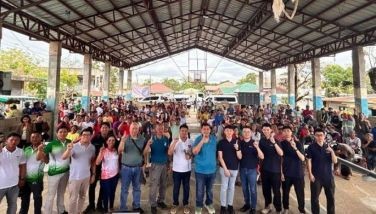Back to stay-at-home

Mobility restrictions are back. But this time, they are self-imposed, and not because of the spread of a contagious new Omicron subvariant.
The reason: eye-popping fuel prices, with no near-term relief in sight. Combined with increases in road toll rates and higher commodity prices all around, people are returning to stay-at-home work, entertainment and get-togethers.
Inevitably, this trend will slow down economic recovery, particularly in tourism and related hospitality enterprises.
Leisure travel plans are being limited to sites close to home. You can see this in the weekend crowds, which should be much larger with the easing of COVID capacity limits, but which are not, even on payday weekends.
Residents in areas near popular tourist destinations are lucky; they can engage in revenge tourism and enjoy the beaches and trekking areas near their communities, without fuel and transport costs eating up three-fourths of their leisure travel budget.
For many residents of Metro Manila, however, revenge tourism will have to wait. Their idea of a day trip is a visit to a weekend market close to home.
The government has been counting on domestic tourism to jump-start the sector’s recovery. But in certain areas outside Metro Manila, pump prices have hit P100 per liter, as shown in TV news reports.
And energy experts are warning that we ain’t seen nothing yet.
* * *
Mass transport drivers and operators aren’t the only ones who are opting to take a prolonged holiday or make a permanent livelihood shift. As I have written, fisherfolk are also grounding their boats. Farmers are switching back to their carabao for tilling the land, slow and cantankerous as the water buffalo may be.
It’s just right that the marginalized sectors get some relief from the state. But the middle class – among the biggest contributors to the consumption-driven economy – are also crying out for relief. The income tax reduction has helped, but inflation, at 5.4 percent the highest in over three years, is negating this.
If the fuel crisis persists (since Russia’s Vladimir Putin shows no sign of slowing down in Ukraine), even the full resumption of face-to-face classes in the coming school year – pushed by economists to hasten recovery – would face a serious snag: there won’t be enough rides for the millions of students who are returning to classrooms.
* * *
The increase of P1 in the minimum jeepney fare translates into additional daily earnings of P483 per driver, according to the Land Transportation Franchising and Regulatory Board.
LTFRB Executive Director Tina Cassion said it was tough to balance the needs of jeepney drivers and operators with the impact of higher fares on inflation and commuters’ finances.
Reports of jeepney drivers finding new livelihood sources and operators grounding or selling their vehicles, leading to those long lines for rides, persuaded the LTFRB to approve the P1 provisional fare hike.
Yesterday, the increase seemed to ease commuters’ struggles for a ride. The coming days will show if jeepney drivers and operators will find the provisional relief enough to keep their livelihood viable, amid three-year-high inflation and more fuel price increases.
Cassion told us on OneNews’ “The Chiefs” shortly after the fare hike was announced Wednesday night that the LTFRB is also considering applications for fare hikes for ride-hailing services.
The fuel price surge appears to have also dampened drivers’ participation in ride-hailing services; there are numerous accounts of people finding it tough to book rides these days.
There are anecdotal stories of car owners deciding to commute to save on fuel expenses. A number of them, according to some reports, opt for a free commute under the Libreng Sakay program. This is also believed to be contributing to those unusually long, snaking lines for buses.
* * *
Cash assistance is being distributed to the transport sector, wages have been raised, and now the minimum jeepney fare has been increased.
The only thing that the government refuses to do is suspend or reduce the fuel taxes. The higher the prices of crude oil and refined petrol at the pumps, the larger the windfall in revenues that are automatically collected.
With the pandemic-induced economic contraction drastically shrinking the revenue base, and with the national debt soaring to P12.7 trillion, it’s understandable that finance managers will refuse to let go of fuel taxes.
It’s easier than devising ways of broadening the tax base for greater coverage of e-commerce and digital platforms, for example, as suggested by certain multilateral lenders.
At first glance, an excise tax of P6 per liter seems like peanuts. But for a full tank of 50 liters, that P6 translates into P300.
At 10 kilometers per liter, a motorist in Quezon City will need about 20 liters to visit Pagsanjan, Laguna and then return, for example, and about 19 liters for swimming in Anilao, Batangas. After the increase of P6.50 per liter for diesel this week, the 20 liters will cost about P1,600. This is apart from the expressway tolls along the way, which could amount, back and forth, to another P1,600.
For the middle class, that’s money better spent on more affordable leisure activities closer to home, or even on basic commodities.
And for those who depend heavily on petroleum products for a living, the prospect of pump prices still going up, up and away is enough argument for a livelihood change.
- Latest
- Trending




























